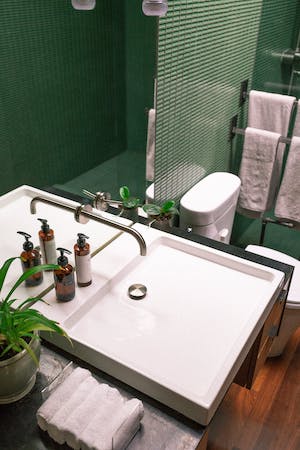Back in the old days, bathrooms were hardly a subject even worth discussing. There was the Girls bathroom and the Boys bathroom. Most folks never gave this approach a second thought but today, that two option system no longer works for every student. Many young people today do not identify as ‘boy’ or ‘girl’. Instead, there are new ways to define gender that are not locked into the traditional split of male or female.
For these students, using the bathroom can be a scary experience, so schools across the nation have been grappling with how to deal with this problem. So far, the solutions are both interesting and numerous, but before we look at those solutions, let’s take a little trip back in time and see where this current situation began.
 Toilet Pioneers
Toilet Pioneers
Until about a decade ago, restrooms were still divided into the traditional models of boys bathrooms and girls bathrooms. Each bathroom would have a row of stalls (hopefully with functioning doors) and outside the stalls would be sinks, soap, and mirrors. Newer built schools often saved money by having one bank of sinks wedged in between both bathrooms but the toilet stalls are still in separate rooms.
Then in Washington State in 2013, Grant High School, installed six single stall unisex bathrooms to meet the needs of several transgender students. Transgender senior Scott Morrison spearheaded the effort explaining that he was “not comfortable” using either the men’s or women’s restroom. Vice principal Krystyn Westphal emphasized in an interview at the time, "We just need to make sure that all students are safe and comfortable here, and that they have their needs met. If they feel unsafe using the bathroom, that's a problem."
Making moves
Across the country in Vermont, transgender high school student Kyle Giard Chase also made a mark on the local bathroom scene. Born female but identifying as male, Kyle would literally ‘hold it’ all day in middle school rather than using the school’s bathrooms. Then, when Kyle got to high school and saw that they had several gender-neutral bathrooms it was such a relief that Kyle began a campaign to have at least one gender- neutral bathroom in every middle and high school in the state. Kyle said at the time, "This procedure of 'holding it' caused me to pay less attention in class, neglect my studies, and fear going to school in the morning.”
By advocating for more gender-neutral bathrooms Kyle could try and ensure that future students don’t have to go through the same terrible experiences.
Advocacy in action
In other states these ‘toilet pioneers’ are quite a bit younger. Colorado youngster Coy Mathis was born male but identified as a female by kindergarten. A year later, in 1st grade, the school district banned Coy from using the girls restroom because they said some parents might get upset. Coy’s parents fought back and ultimately won a legal battle against the school district allowing Coy to use the girl’s bathroom. Coy’s mother told local news "This is amazing because it is not just a win for Coy, but a win for every transgender child in the entire state,"
Simple Solutions
To provide students of all genders with a safe space to use the restroom, schools have experimented with a variety of mostly successful approaches. Obviously, a solution that works well in high school or college may not work well in the lower grades but the spectrum of bathroom usage is quite wide.
Neutral bathrooms are probably the most common and basic approach. These restrooms are almost always single-stall with a lockable door and a sink located inside the restroom. One problem with these however is that there are not that many of them and sometimes they are inconveniently located. A Colorado teacher we spoke with mentioned that while they do have several gender-neutral bathrooms at her middle school, “... we don't know how many kids who'd like to use it (for example, sixth graders who don't come onto the 7th grade floor) are unaware of its existence.”
Another approach that was rare but is becoming more common are multi-stall gender neutral bathrooms. Imaging a traditional bathroom where you walk in and there is a row of sinks across from a row of toilet stalls. The only difference being that all-genders are welcome in the restroom so you may have a male and a female both relieving themselves in adjacent stalls. This may sound awkward as most of us are not used to using the toilet with the opposite sex nearby, but most students find that after the first few weeks this awkwardness dissipates and gender neutral restrooms become just another aspect of everyday life.
 Finally, in a pinch, some schools are simply suggesting that students who don’t feel comfortable using the ‘boys’ or ‘girls’ room can use the bathroom designated for staff. These are commonly single stall lockable restrooms that provide the student with both the needed privacy and often a cleaner experience. While this approach often works in the short term, parents have complained that the student can feel isolated from peers when not allowed to use the restroom of the gender with which they identify.
Finally, in a pinch, some schools are simply suggesting that students who don’t feel comfortable using the ‘boys’ or ‘girls’ room can use the bathroom designated for staff. These are commonly single stall lockable restrooms that provide the student with both the needed privacy and often a cleaner experience. While this approach often works in the short term, parents have complained that the student can feel isolated from peers when not allowed to use the restroom of the gender with which they identify.
Moving Forward
In the long run, we need to approach this bathroom battle with a different lens. As our teacher from Colorado put it, “To truly address this issue, school districts need to invest some money in the design and construction of non-gendered bathrooms and changing spaces, rather than haphazardly retro-fitting existing spaces when someone protests. Ideally, it should be standard in all new school construction and there should be a proactive plan to re-design existing facilities.” So far, many school districts have just started down this path.
So, while we may have a long way to go before the battle of the bathrooms is over, at least the will and effort are there.
By Senor K
